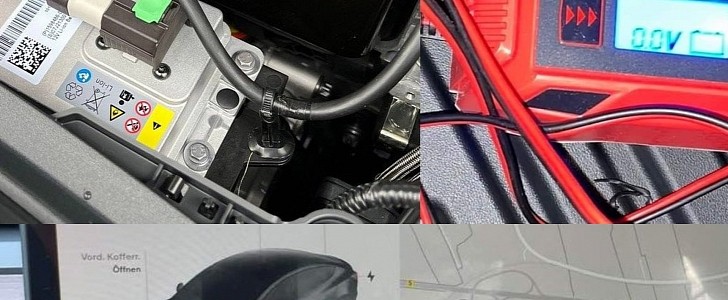Tesla has replaced the classic lead-acid low-voltage battery with a Li-Ion counterpart and all sorts of problems started to appear. In one of the latest, those batteries are dying on the LFP Model 3 cars, leaving owners stranded on the side of the road. Tesla identified the problem as a “calibration problem” and moved to solve it with a software update.
It was believed that lead-acid batteries still have life under the hood of electric vehicles. After all, most of them still feature low voltage batteries based on that ancient technology. But then came Tesla and wanted to prove Li-Ion is better, only to start running into all sorts of problems with this approach.
First, there was the fact that the Li-Ion battery has a different voltage from its lead-acid counterpart (15.5 volts compared to 13.2 volts). That’s fine in a car that was built around this new technology, but when that car needs to tow a trailer, this means no auxiliary power for the latter due to incompatible voltage. Secondly, it appears the new Li-Ion low-voltage battery does not get along well with the new LFP batteries in the Tesla Model 3 RWD.
According to lots of user complaints, the 12-volt li-ion battery on vehicles equipped with LFP batteries can die in less than 20 minutes after the vehicle’s main battery reaches a state of charge of less than 10%. When this happens, the car cannot be started or even charged. To make the matter worse, it cannot be jumpstarted with a lead-acid battery, because of the incompatible voltage.
The problem only appears on the LFP-powered vehicles because it inconsistently reports the real state of charge. This means it sometimes overestimates or underestimates the range. When the former happens, it will probably drop the charge much faster than expected. Many users experienced a flat battery miles away from the charger. The NCA batteries do not suffer from this problem and usually, their state of charge reporting is accurate.
Tesla acknowledged the issue and came up with a solution to solve the calibration problem. Instead of the recommendation to fully charge the Li-ion battery at least once a week, the car will do this automatically, while notifying the owner. Once the Li-Ion battery gets to 100% it will calibrate itself and the state of charge will be accurately reported.
“The charge limit in your vehicle has been automatically adjusted to 100%. The range display in your vehicle is undergoing calibration. Until calibrated, displayed range my under or overestimate compared to distance driven,” reads the message displayed on the Model 3’s screen. “To improve accuracy, charge to 100%. It is recommended for this configuration of vehicle to keep your charge limit set to 100%, even for daily use, and that you also fully charge to 100% at least once per week.”
We’ve earlier reported about Tesla’s recommendation to fully charge the LFP batteries on a regular basis. It now appears the EV maker took a more aggressive stance towards this. The LFP batteries are considered inferior to their NCA counterparts because of the lower energy density, but they proved very good in winter conditions and also on longer trips.
First, there was the fact that the Li-Ion battery has a different voltage from its lead-acid counterpart (15.5 volts compared to 13.2 volts). That’s fine in a car that was built around this new technology, but when that car needs to tow a trailer, this means no auxiliary power for the latter due to incompatible voltage. Secondly, it appears the new Li-Ion low-voltage battery does not get along well with the new LFP batteries in the Tesla Model 3 RWD.
According to lots of user complaints, the 12-volt li-ion battery on vehicles equipped with LFP batteries can die in less than 20 minutes after the vehicle’s main battery reaches a state of charge of less than 10%. When this happens, the car cannot be started or even charged. To make the matter worse, it cannot be jumpstarted with a lead-acid battery, because of the incompatible voltage.
The problem only appears on the LFP-powered vehicles because it inconsistently reports the real state of charge. This means it sometimes overestimates or underestimates the range. When the former happens, it will probably drop the charge much faster than expected. Many users experienced a flat battery miles away from the charger. The NCA batteries do not suffer from this problem and usually, their state of charge reporting is accurate.
Tesla acknowledged the issue and came up with a solution to solve the calibration problem. Instead of the recommendation to fully charge the Li-ion battery at least once a week, the car will do this automatically, while notifying the owner. Once the Li-Ion battery gets to 100% it will calibrate itself and the state of charge will be accurately reported.
“The charge limit in your vehicle has been automatically adjusted to 100%. The range display in your vehicle is undergoing calibration. Until calibrated, displayed range my under or overestimate compared to distance driven,” reads the message displayed on the Model 3’s screen. “To improve accuracy, charge to 100%. It is recommended for this configuration of vehicle to keep your charge limit set to 100%, even for daily use, and that you also fully charge to 100% at least once per week.”
We’ve earlier reported about Tesla’s recommendation to fully charge the LFP batteries on a regular basis. It now appears the EV maker took a more aggressive stance towards this. The LFP batteries are considered inferior to their NCA counterparts because of the lower energy density, but they proved very good in winter conditions and also on longer trips.
Investigating
— Elon Musk (@elonmusk) March 2, 2022






